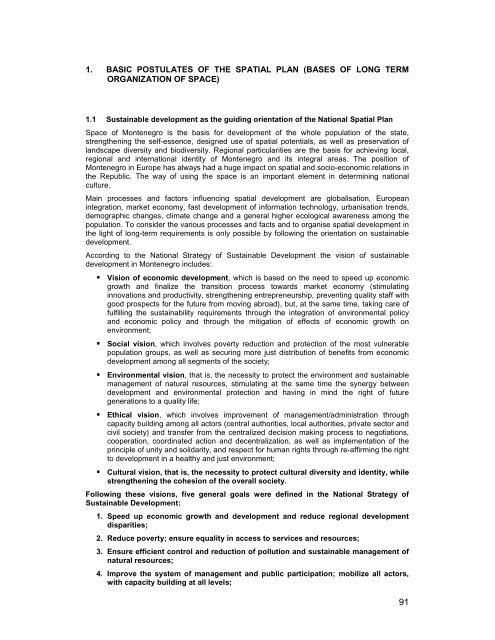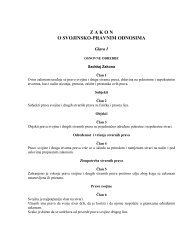Spatial plan of Montenegro until 2020 - Ada Bojana
Spatial plan of Montenegro until 2020 - Ada Bojana
Spatial plan of Montenegro until 2020 - Ada Bojana
You also want an ePaper? Increase the reach of your titles
YUMPU automatically turns print PDFs into web optimized ePapers that Google loves.
1. BASIC POSTULATES OF THE SPATIAL PLAN (BASES OF LONG TERMORGANIZATION OF SPACE)1.1 Sustainable development as the guiding orientation <strong>of</strong> the National <strong>Spatial</strong> PlanSpace <strong>of</strong> <strong>Montenegro</strong> is the basis for development <strong>of</strong> the whole population <strong>of</strong> the state,strengthening the self-essence, designed use <strong>of</strong> spatial potentials, as well as preservation <strong>of</strong>landscape diversity and biodiversity. Regional particularities are the basis for achieving local,regional and international identity <strong>of</strong> <strong>Montenegro</strong> and its integral areas. The position <strong>of</strong><strong>Montenegro</strong> in Europe has always had a huge impact on spatial and socio-economic relations inthe Republic. The way <strong>of</strong> using the space is an important element in determining nationalculture.Main processes and factors influencing spatial development are globalisation, Europeanintegration, market economy, fast development <strong>of</strong> information technology, urbanisation trends,demographic changes, climate change and a general higher ecological awareness among thepopulation. To consider the various processes and facts and to organise spatial development inthe light <strong>of</strong> long-term requirements is only possible by following the orientation on sustainabledevelopment.According to the National Strategy <strong>of</strong> Sustainable Development the vision <strong>of</strong> sustainabledevelopment in <strong>Montenegro</strong> includes: Vision <strong>of</strong> economic development, which is based on the need to speed up economicgrowth and finalize the transition process towards market economy (stimulatinginnovations and productivity, strengthening entrepreneurship, preventing quality staff withgood prospects for the future from moving abroad), but, at the same time, taking care <strong>of</strong>fulfilling the sustainability requirements through the integration <strong>of</strong> environmental policyand economic policy and through the mitigation <strong>of</strong> effects <strong>of</strong> economic growth onenvironment; Social vision, which involves poverty reduction and protection <strong>of</strong> the most vulnerablepopulation groups, as well as securing more just distribution <strong>of</strong> benefits from economicdevelopment among all segments <strong>of</strong> the society; Environmental vision, that is, the necessity to protect the environment and sustainablemanagement <strong>of</strong> natural resources, stimulating at the same time the synergy betweendevelopment and environmental protection and having in mind the right <strong>of</strong> futuregenerations to a quality life; Ethical vision, which involves improvement <strong>of</strong> management/administration throughcapacity building among all actors (central authorities, local authorities, private sector andcivil society) and transfer from the centralized decision making process to negotiations,cooperation, coordinated action and decentralization, as well as implementation <strong>of</strong> theprinciple <strong>of</strong> unity and solidarity, and respect for human rights through re-affirming the rightto development in a healthy and just environment; Cultural vision, that is, the necessity to protect cultural diversity and identity, whilestrengthening the cohesion <strong>of</strong> the overall society.Following these visions, five general goals were defined in the National Strategy <strong>of</strong>Sustainable Development:1. Speed up economic growth and development and reduce regional developmentdisparities;2. Reduce poverty; ensure equality in access to services and resources;3. Ensure efficient control and reduction <strong>of</strong> pollution and sustainable management <strong>of</strong>natural resources;4. Improve the system <strong>of</strong> management and public participation; mobilize all actors,with capacity building at all levels;91







